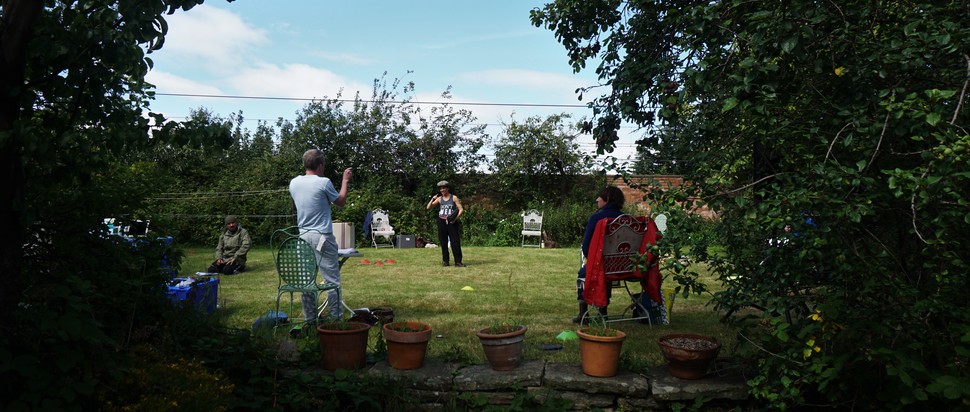Brave New Stages: Theatre design and COVID-19
Scotland's theatre industry is struggling to survive under the pressure of social distancing regulations. Meet the designers thinking outside the box to stage new work
Imagine this: entering a building, without a face-mask. The building itself might be hundreds of years old – it could be so ancient that it was built for people who were, on average, a few inches smaller than you. The ventilation is poor and the air is musty. You cram yourself into a tiny seat, elbow to elbow with the stranger beside you.
This scenario might seem almost inconceivable now but, only five months ago, it was the classic night-out-at-the-theatre experience. Since then, Scotland's theatres have closed their doors. Some expect to cautiously reopen on 14 September, the date proposed by First Minister Nicola Sturgeon: others have confirmed that their lights will be off until at least 2021.
In the meantime, theatre companies haven't let the coronavirus and the closure of venues stop them from producing new work. When lockdown hit, theatres around the country adapted swiftly to culture's changing digital landscape. As restrictions ease, companies and artists face a new challenge – how do theatre-makers return to creating physical, live performance while respecting the boundaries necessary for public health and safety?
The answer from many in the sector is frank: either not at all, or shows must be staged completely differently. "With the restrictions in place, it's not safe or financially viable for theatres to open," says Beth Morton, a theatre-maker and director at Mull Theatre, which will remain closed to the public until 2021. But, Morton argues, "we can make work – we just had to think about how to do it."
Now that the government is allowing social 'bubbles' to exist, Mull Theatre came up with an unusual solution that will place the space and set at the epicentre of their autumn season. To produce two new plays by Oliver Emanuel and Anita Vettesse, the creative team of four will form a household bubble, rehearse in the empty theatre, and then have the pieces staged, lit, performed and filmed. It’s what Morton calls 'a digital stage' – a step further than the filmed-at-home theatre shorts that were common during lockdown. "The emphasis is on theatre," she explains. "It's very much an experiment: this is work that has been commissioned for stage, we're staging it for theatre – so how will filming it work?"
When it comes to inviting audiences back into spaces, designers' skills will prove to be critical. "Managing where the actors are, where the audience are... this is part of the job. It's nothing new," says designer Karen Tennent, who has worked with companies such as Dundee Rep Theatre and the National Theatre of Scotland. "I think we are going to be pivotal in moving things forward." Tennent has been working with performance company Curious Seed on a project called Field – Something For The Future Now. The piece, which is a research project rather than a performance, grew out of dancers practising outside in Holyrood Park due to lack of studio space during the pandemic. "It's not something that we've adapted [that] was going to happen anyway," she says. "It’s about using what happened to create something in reaction to where we are."
Katy Rae Wilson, the designer and creator of interactive all-ages-gig Sprog Rock, has also used the government restrictions as an opportunity to venture outdoors, something she says her work was "steering in the direction of" anyway. "I don't want to undermine the struggles that are very real for venues and people in theatre – but as a freelancer, I can take the restrictions and the challenges that we have and try to make something positive out of it," she tells us. For Wilson, that means focusing on creating sustainable live performance while following regulations. "I've been thinking about using the Scottish landscape as a backdrop as much as I can," she says.
Theatre may be in a gloomy place generally, but is there anything exciting about the challenges posed by the current situation for designers? Tennent thinks so: "To keep in with the government guidelines, you have to be flexible and nimble. But as designers, we always have to be flexible and nimble," she laughs.
"[We think about] space all the time – we can be consulted, not just on how to design a show, but also on how to have the audience physically distanced. We can do that in an interesting way, making it part of the show that's being told by the rest of the team, rather than in a purely practical way." Award-winning designer Becky Minto, who is currently working on a show called Doppler with site-specific company Grid Iron, agrees. "Could [socially distanced] design become part of the language of the story that we're telling?" she asks. "Restrictions can sometimes create a wonderful possibility about how else we envision putting on performances."
The problems faced by those staging new work are very real, but the creatives we speak to all agree that designers are nothing if not resourceful. Minto recalls taking over from another designer, Janet Scarfe, early on in her career. "I said, 'is there anything I need to know?' she said, 'there's no flys, no wings and no money... but apart from that, you can do anything you like.' I've never forgotten that." And Wilson suggests that as long as imagination lives on, we'll find a way to tell visually arresting stories. "If we genuinely listen to what people need," she says, "we can always make some kind of magic and excitement from what we have."
comar.co.uk/journal/emergence-two-brand-new-plays-theatre
curious-seed.com
kate-wilson.co.uk
gridiron.org.uk/doppler-update/
